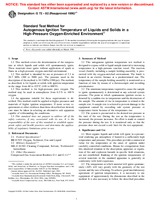We need your consent to use the individual data so that you can see information about your interests, among other things. Click "OK" to give your consent.
ASTM G72-82(1996)e1
Standard Test Method for Autogenous Ignition Temperature of Liquids and Solids in a High-Pressure Oxygen-Enriched Environment (Includes all amendments And changes 8/16/2017).
Automatically translated name:
Standard Test Method for Autogenous Ignition Temperature of Liquids and Solids in a High-Pressure Oxygen-Enriched Environment
STANDARD published on 10.9.2001
The information about the standard:
Designation standards: ASTM G72-82(1996)e1
Note: WITHDRAWN
Publication date standards: 10.9.2001
SKU: NS-57799
The number of pages: 5
Approximate weight : 15 g (0.03 lbs)
Country: American technical standard
Category: Technical standards ASTM
Annotation of standard text ASTM G72-82(1996)e1 :
Keywords:
autogenous ignition temperature, ignition temperature, oxygen enriched environment, ICS Number Code 13.220.40 (Ignitability and burning behaviour of materials and products), 13.230 (Explosion protection)
Additional information
| Significance and Use | ||||||||||||
|
Most organic liquids and solids will ignite in a pressurized oxidizing gas atmosphere if heated to a sufficiently high temperature and pressure. This procedure provides a numerical value for the temperature at the onset of ignition under carefully controlled conditions. Means for extrapolation from this idealized situation to the description, appraisal, or regulation of fire and explosion hazards in specific field situations, are not established. Ranking of the ignition temperatures of several materials in the standard apparatus is generally in conformity with field experience. The temperature at which material will ignite spontaneously (AIT) will vary greatly with the geometry of the test system and the rate of heating. To achieve good interlaboratory agreement of ignition temperatures, it is necessary to use equipment of approximately the dimensions described in the method. It is also necessary to follow the described procedure as closely as possible. The decomposition and oxidation of some fully fluorinated materials releases so little energy that there is no clear-cut indication of ignition. Nor will there be a clear indication of ignition if a sample volatilizes, distilling to another part of the reaction vessel, before reaching ignition temperature.
|
||||||||||||
| 1. Scope | ||||||||||||
|
1.1 This method covers the determination of the temperature at which liquids and solids will spontaneously ignite. These materials must ignite without application of spark or flame in a high-pressure oxygen-enriched environment. 1.2 This method is intended for use at pressures of 2.1 to 20.7 MPa (300 to 3000 psi). The pressure used in the description of the method is 10.3 MPa (1500 psi). The method, as described, is for liquids or solids with ignition temperature in the range from 60 to 425°C (140 to 800°F). 1.3 This method is for high-pressure pure oxygen. The method may be used in atmospheres from 0.5 % to 100 % oxygen. 1.4 An apparatus suitable for these requirements is described. This method could be applied to higher pressures and materials of higher ignition temperature. If more severe requirements or other oxidizers than those described are desired, care must be taken in selecting an alternative safe apparatus capable of withstanding the conditions. 1.5 This standard does not purport to address all of the safety concerns, if any, associated with its use. It is the responsibility of the user of this standard to establish appropriate safety and health practices and determine the applicability of regulatory limitations prior to use. |
||||||||||||
| 2. Referenced Documents | ||||||||||||
|
We recommend:
Technical standards updating
Do you want to make sure you use only the valid technical standards?
We can offer you a solution which will provide you a monthly overview concerning the updating of standards which you use.
Would you like to know more? Look at this page.




 Cookies
Cookies
